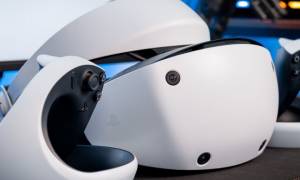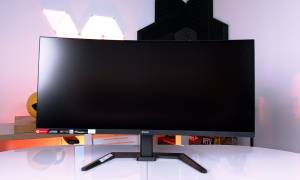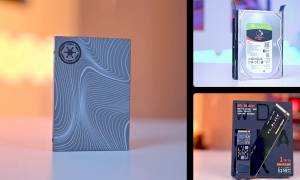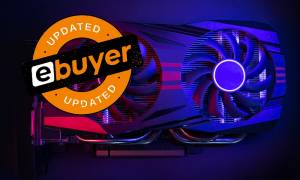Image by: AMD
At their ‘together we advance PCs’ event, AMD unveiled the RX 7900 XT and 7900 XTX, powered by the latest RDNA 3 GPU architecture. These GPUs sit right at the top of AMD’s new Radeon 7000 Series, going up against the NVIDIA RTX 4080 16GB from the RTX 40 Series. That’s not all that was shown at the event. AMD also announced FSR 3 with ‘Fluid Motion Technology’, a la DLSS Frame Generation.
Radeon RX 7000 Series Line-Up
|
Model |
Compute Units |
Ray Accelerators |
Game Frequency |
Infinity Cache |
Max Memory Size |
Memory Type |
Total Board Power |
MSRP |
|
AMD Radeon RX 7900 XT |
84 |
84 |
2,000MHz |
80MB |
20GB |
GDDR6 |
300W |
$899 |
|
AMD Radeon RX 7900 XTX |
96 |
96 |
2,300MHz |
96MB |
24GB |
GDDR6 |
335W |
$999 |
World’s First Gaming GPUs with Chiplet Technology

Image by: AMD
With RDNA 3, AMD’s transitioning to a chiplet GPU architecture. The chiplet design of AMD’s Ryzen CPUs and now their Radeon GPUs has several advantages over the traditional ‘monolithic’ designed used by Intel and NVIDIA.
By separating the chip into chiplets, each section of the chip can be tested and validated individually. In the case of RDNA 3, that’s one graphics compute die (GCD) and six memory cache dies (MCD). This improves yields in the manufacturing process as the whole chip doesn’t have to be thrown out if just a single section is defective, or ‘binned’ as a weaker model.
What’s more, it’s more cost-effective as each section can be manufactured on their own node process. For example, the GCDs of RDNA 3 leverages TSMC’s latest 5nm process, whereas the less important MCDs fall back to the older – and cheaper – 6nm process. Obviously, AMD could just pocket any saving made. As you’ll see with the price tag of Radeon RX 7000 Series GPUs, however, it’s allowed them to price more aggressively.
So these chiplets can communicate with each other as fast as possible for optimal performance, RDNA 3 features a 2nd-generation Infinity Cache hooked up through an high-bandwidth chiplet interconnect running at a ridiculously-fast 5.3TB/s.
Raytracing & AI

Image by: AMD
While the raw rasterization performance of RDNA 2 GPUs was strong, the real-time raytracing performance lagged a generation behind NVIDIA, and they didn’t feature dedicated AI-acceleration hardware at all.
AMD’s looking to address both shortcomings with RDNA 3. RDNA 3 features new AI Accelerators and 2nd-gen Raytracing Accelerators for greatly enhanced performance.
Compared to the RX 6900 XT, the new RX 7900 XTX achieved up to 2.7x more performance in AI acceleration and up to 50% more raytracing performance per CU. Although these 2nd-gen Raytracing Accelerators support new dedicated instructions, 1.5x more rays in flight and new ray box sorting and traversal, it’s looking like AMD hasn’t quite caught up to NVIDIA in regard to real-time raytracing performance, who’ve gone all-in on the technology.
DisplayPort 2.1 & AV1 Support

Image by: AMD
If you were left disappointed by the lack of DisplayPort 2.1 on the NVIDIA RTX 4090, AMD’s got you covered. RDNA 3 GPUs are equipped with the new AMD Radiance Display Engine, featuring support for DisplayPort 2.1 This enables 12-bit HDR at up to 8K, 165Hz or 4K, 480Hz. It’ll be a while until displays running these resolutions and refresh rates hit the market, however.
Rounding out RDNA 3’s multi-media experiences is a dual media engine with full AV1 encode/decode support, designed for high-quality video streaming, as well as machine learning-enhanced video encoding.
Radeon RX 7000 Series Gaming Performance
|
Game (4K Max Settings) |
Frames-Per-Second (Up To) |
|
Call of Duty: Modern Warfare 2 |
139 |
|
God of War |
98 |
|
Red Dead Redemption 2 |
93 |
|
Assassin’s Creed Valhalla |
109 |
|
Resident Evil Village (Raytracing) |
138 |
|
Doom Eternal (Raytracing) |
135 |
AMD shared some performance figures for the Radeon RX 7900 XTX. Though, take these frame rates with a pinch of salt as they’re “up to”, not averages.
For a head-to-head comparison against an existing card, the RX 7900 XT is up to 1.6x faster versus the RX 6950 XT at 4K. It’s shaping up to be a great card for those wanting to max-out their games on a high refresh rate 4K gaming monitor – and the RX 7900 XTX will be even faster still.
Power Consumption

Image by: AMD
With over 50% greater performance-per-watt than RDNA 2, these cards are great performers for their power consumption. You likely won’t have to upgrade your power supply or computer case to support these cards either.
Despite the huge performance increase, AMD’s reference cooler design for the RX 7900 XTX is only a bit longer than the RX 6950 XT at 287mm, while sharing the same 2.5 slot size. Unlike the RTX 4090, which opted for a newer but unproven 12-pin power connecter, these cards are sticking to two regular 8-pin power connectors.
RX 7900 XT & RX 7900 XTX Price

Image by: AMD
And let’s talk about those prices, which fly in the face of NVIDIA CEO’s recent claim that falling GPU prices are “a story of the past.” The new RX 7900 XT’s MSRP comes in $100 lower than the last generation RX 6900 XT, while the top-end RX 7900 XTX is looking like a considerably cheaper option than NVIDIA’s current offerings.
Of course, we should wait until release as AMD could’ve cherry-picked these performance figures. Vague language like “up to” or the lack of a direct comparison to the competition’s cards doesn’t help either. Nonetheless, we’re interested to see how NVIDIA responds to the announcement, if at all. Will they bring back the ‘unlaunched’ RTX 4080 12GB at a lower price to compete with the RX 7900 XT?
FSR 3 & Fluid Motion Frames Technology

Image by: AMD
FSR 2 debuted earlier this year. It was a total technological revamp of FSR 1, going from a simple spatial upscaling to a proper image reconstruction technology. AMD’s not done yet, however. At the event, they announced a brand-new version of FidelityFX Super Resolution, FSR 3.
FSR 3 combines the temporal up-sampling element of FSR 2 with AMD’s new ‘Fluid Motion Frames’ technology to deliver more frames in your games, up to a 2x increase to frames-per-second at 4K over FSR 2. Only a tiny snippet of the technology in action was shown, nor did AMD go into much detail. It wasn’t even clarified if it’s exclusive to Radeon RX 7000 Series GPUs. If we had to guess, we’d say it’s AMD’s equivalent of NVIDIA’s DLSS Frame Generation technology. Hopefully we’ll hear more info soon as it’s slated to release sometime in 2023.
Radeon RX 7000 Series at Ebuyer
The Radeon RX 7900 XT and 7900 XTX both launch on December 13th. Are you holding out till then, or do you think you’ll pick up an RTX 40 Series GPU instead? Check out our blog AMD Ryzen 7000 Series – What you need to know and put together an all AMD-powered gaming PC.



























